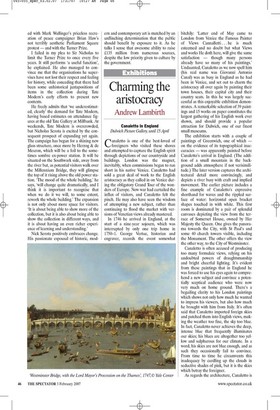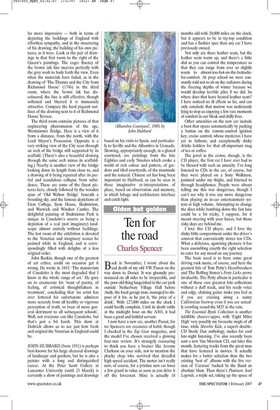Charming the aristocracy
Andrew Lambirth Canaletto in England Dulwich Picture Gallery, until 15 April analetto is one of the best-loved of foreigners who visited these shores and attempted to capture the English spirit through depictions of our countryside and buildings. London was the magnet, inevitably, when commissions began to run short in his native Venice. Canaletto had sold a great deal of work to the English aristocracy as they called in on Venice during the obligatory Grand Tour of the wonders of Europe. Now war had curtailed the influx of visitors, and Canaletto felt the pinch. He may also have seen the wisdom of attempting a new subject, rather than continuing to flood the market with versions of Venetian views already mastered.
In 1746 he arrived in England, at the start of a nine-year sojourn, which was interrupted by only one trip home in 1750-1. George Vertue, historian and engraver, records the event somewhat bitchily: 'Latter end of May came to London from Venice the Famous Painter of Views Cannalletti ... he is much esteemed and no doubt but what Views and works He doth here, will give the same satisfaction — though many persons already have so many of his paintings.' Undaunted, Canaletto as we now spell him (his real name was Giovanni Antonio Canal) was as busy in England as he had been in Venice, and set out to charm the aristocracy all over again by painting their town houses, their capital city and their country seats. In this he was largely successful as this enjoyable exhibition demonstrates. A remarkable selection of 39 paintings and 15 works on paper constitutes the largest gathering of his English work ever shown, and should provide a popular attraction for Dulwich, one of our finest small museums.
The exhibition starts with a couple of paintings of Greenwich, one of which — on the evidence of its topographical inaccuracies — was apparently painted before Canaletto's arrival in England. (The addition of a small mountain in the background adds atmosphere if not verisimilitude.) The later version captures the architectural detail more convincingly, and depicts a river busy with craft and implied movement. The earlier picture includes a fine example of Canaletto's expressive shorthand for waves and the rippled surface of water: horizontal open bracket shapes touched in with white. This first room is dominated by a pair of splendid canvases depicting the view from the terrace of Somerset House, owned by Her Majesty the Queen. One gives the panorama towards the City, with St Paul's and some 40 church towers visible, including the Monument. The other offers the view the other way, to the City of Westminster.
Canaletto is often accused of producing too many formulaic views, relying on his undoubted powers of draughtsmanship and bright cheerful lighting. It's evident from these paintings that in England he was forced to use his eyes again to comprehend a new subject and convince a potentially sceptical audience who were now very much on home ground. There's a beguiling clarity to his London paintings which shows not only how much he wanted to impress his viewers, but also how much he brought with him from Italy. It's often said that Canaletto imported foreign skies and patched them into English views, making the weather too fine, the sky too blue. In fact, Canaletto never achieves the deep, intense blue that frequently illuminates our skies; his blues are altogether too yellow and sulphurous for our climate. In a word, his skies are not blue enough, and as such they occasionally fail to convince. From time to time he circumvents this inadequacy by curdling up the clouds in seductive shades of pink, but it is the skies which betray the foreigner.
As regards the architecture, Canaletto is far more impressive — both in terms of depicting the buildings of England with effortless sympathy, and in the structuring of his drawing, the building of his own pictures, as it were. Look at the pair of drawings in that first room to the right of the Queen's paintings. The eager fluency of the brown ink line marries perfectly with the grey wash to body forth the view. Even when the materials have faded, as in the drawing of 'The Thames and the City from Richmond House' (1746) in the third room, where the brown ink has discoloured, the line is still effective; though softened and blurred it is immensely attractive. Compare the hard piquant outlines of the drawing next to it of Richmond House Terrace.
The third room contains pictures of that engineering phenomenon of the age, Westminster Bridge. Here is a view of it from a distance, from the north, with the Lord Mayor's Procession. Opposite is a very striking view of the City seen through an arch of the bridge still supported by its scaffold. (There's also a beautiful drawing through the same arch minus its scaffolding.) Nearby is another view of the bridge looking down its length from close to, and a drawing of it being repaired after its partial and scandalous collapse from subsidence. These are some of the finest pictures here, closely followed by the wooden span of 'Old Walton Bridge' beneath a brooding sky, and the famous depictions of Eton College, Syon House, Badminton, and Warwick and Windsor Castles. The delightful painting of Badminton Park is unique in Canaletto's oeuvre as being a depiction of a real (not imaginary) landscape almost entirely without buildings. The last room of the exhibition is devoted to the Venetian and imaginary scenes he painted while in England, and is correspondingly filled with delights of a less original order.
John Ruskin, though one of the greatest of art critics, could on occasion get it wrong. He wrote in 1843: 'The mannerism of Canaletto is the most degraded that I know in the whole range of art.' He goes on to enumerate his 'want of poetry, of feeling, of artistical thoughtfulness in treatment', concluding that 'no artist has ever fettered his unfortunate admirers more securely from all healthy or vigorous perception of truth, or been of more general detriment to all subsequent schools'. Well, not everyone can like Canaletto, but that's just a bit harsh. This show at Dulwich allows us to see just how fresh and original the Venetian in England could be.
JOHN HUBBARD (born 1931) is perhaps best-known for his large charcoal drawings of landscape and gardens, but he is also a painter with a long and distinguished career. At the Peter Scott Gallery at Lancaster University (until 23 March) is currently a show of paintings and drawings based on his visits to Spain, and particularly to Seville and the Alhambra in Granada. Showing, appropriately enough, in a glazed courtyard, are paintings from the late Eighties and early Nineties which evoke a world of rich colour and pattern, of gardens and tiled courtyards, of the manmade and the natural. Chinese art has long been important to Hubbard, as can be seen in these imaginative re-interpretations of place, based on observation and memory, in which foliage and architecture interlace and catch light.





















































 Previous page
Previous page